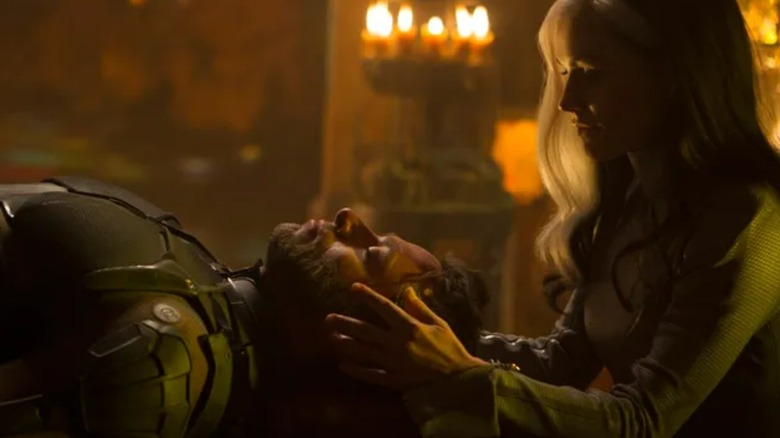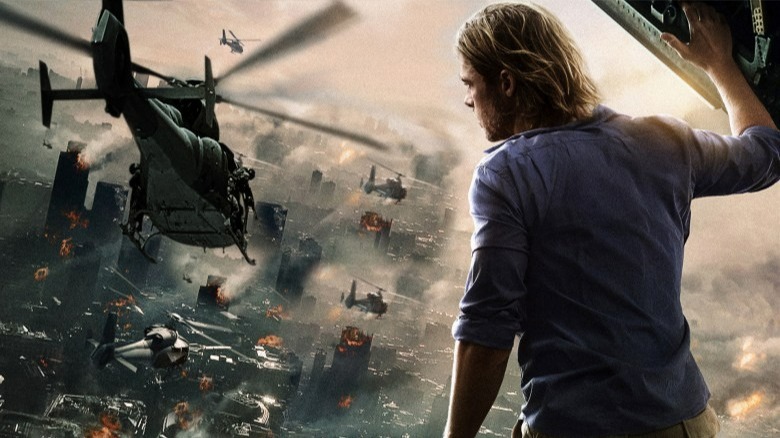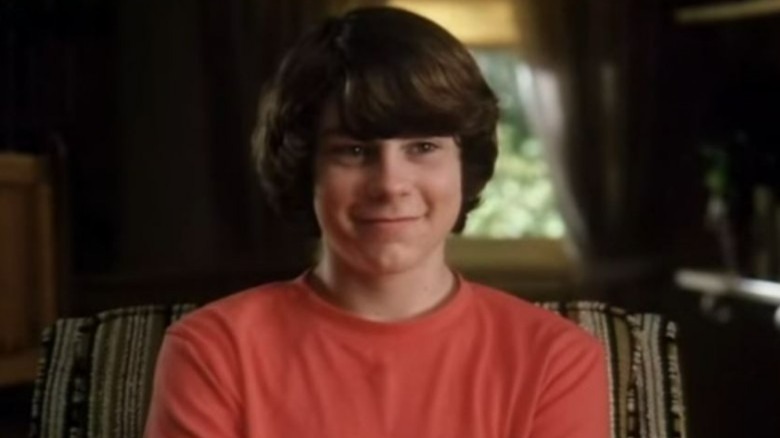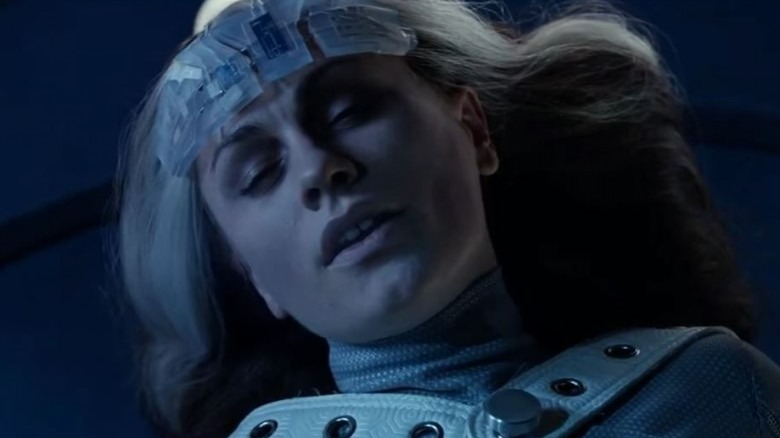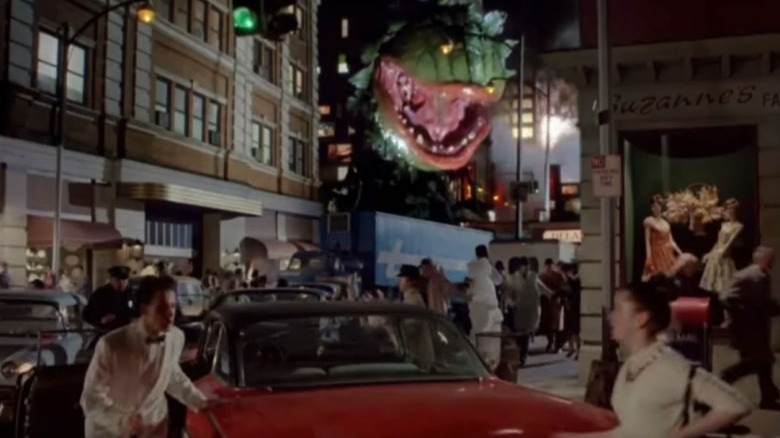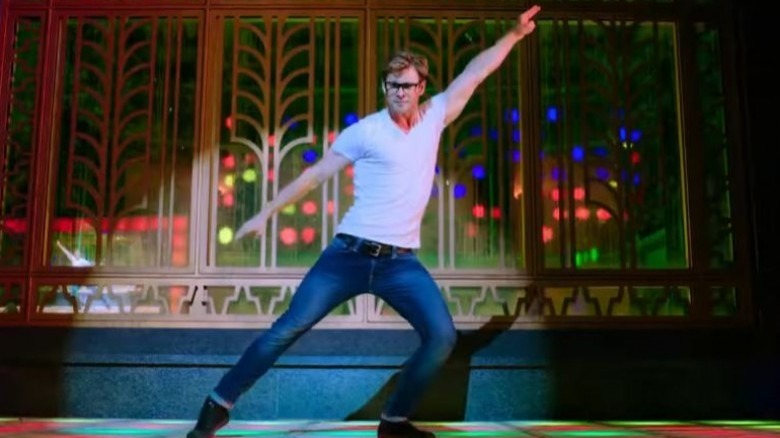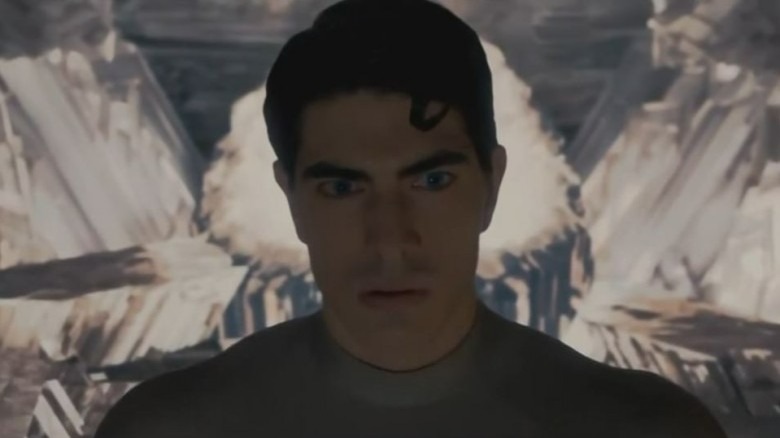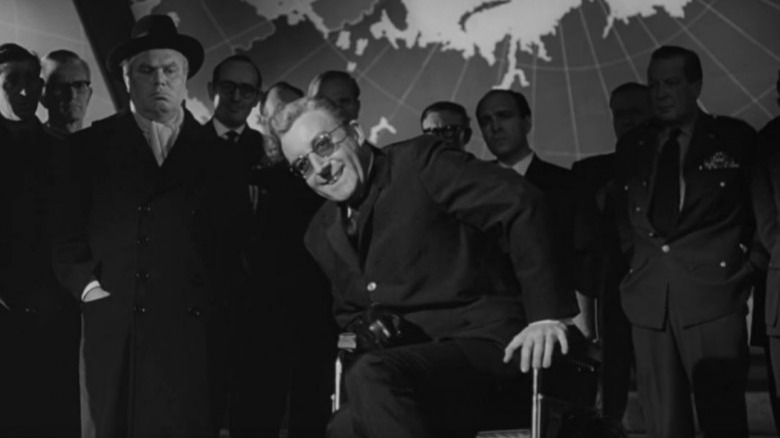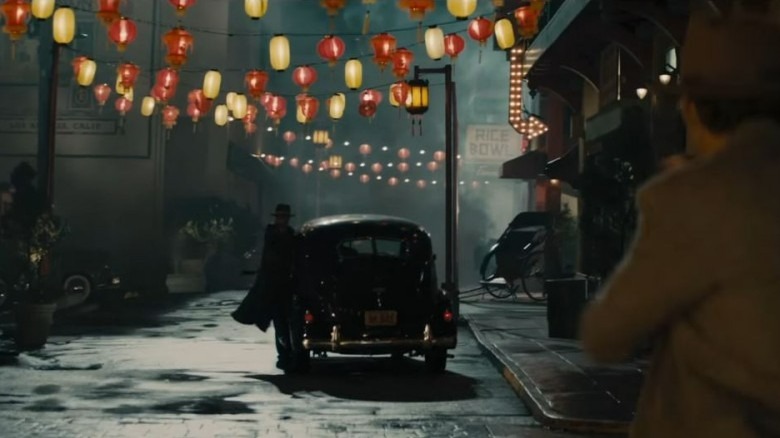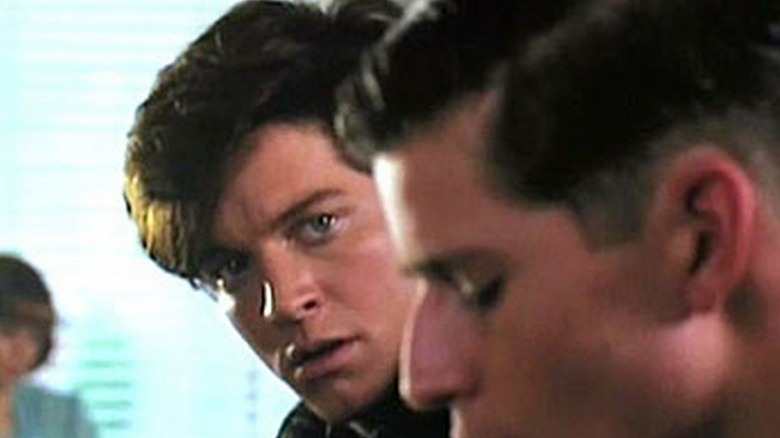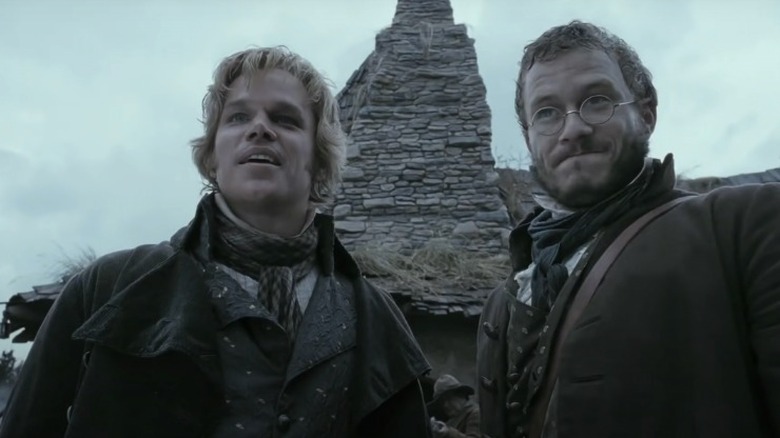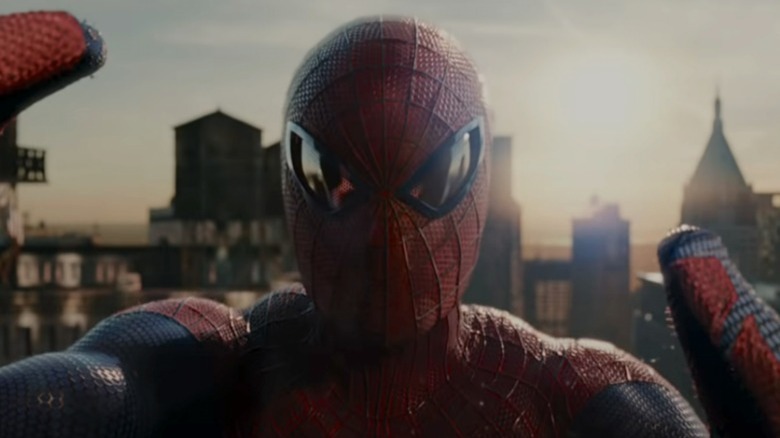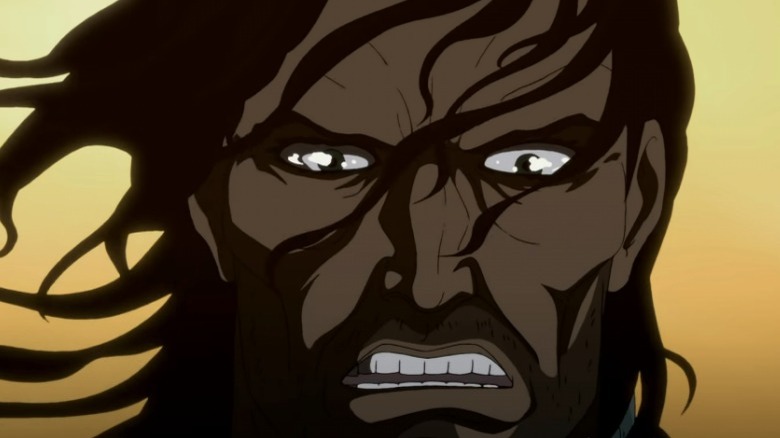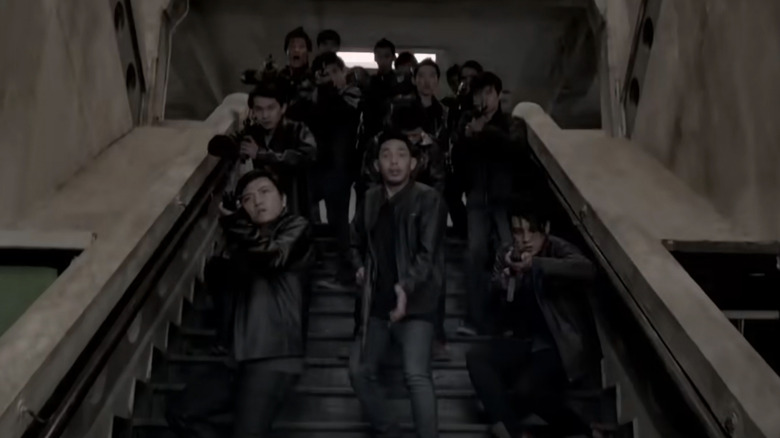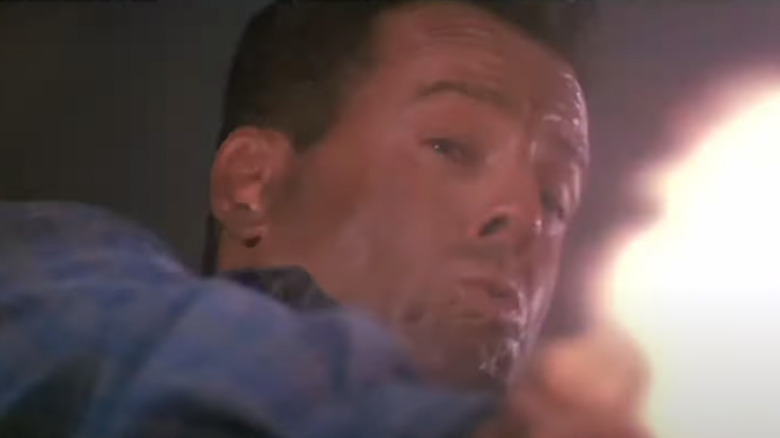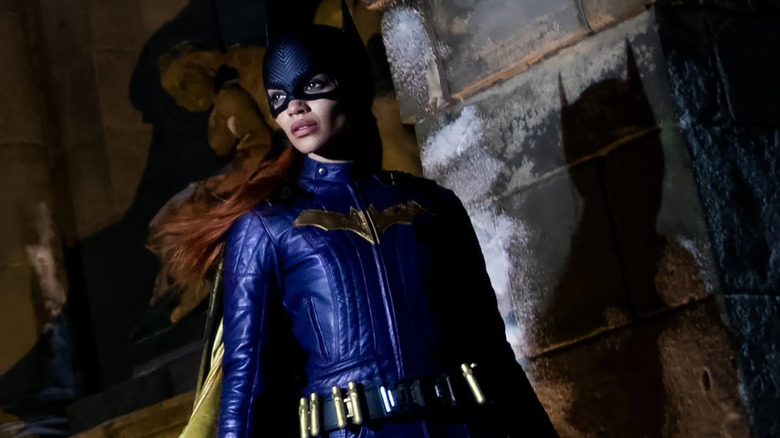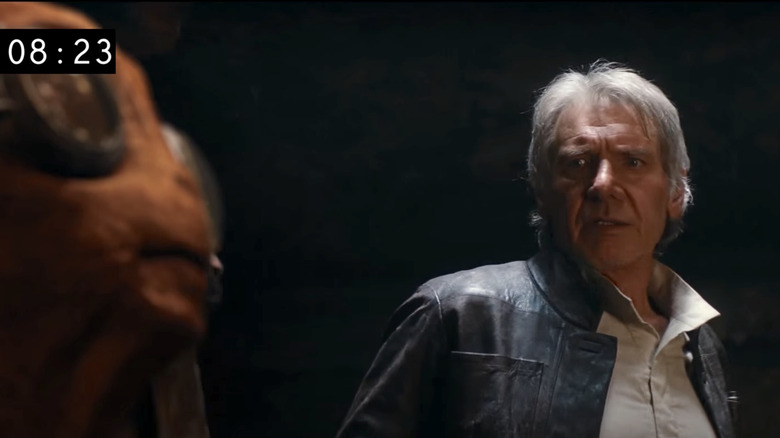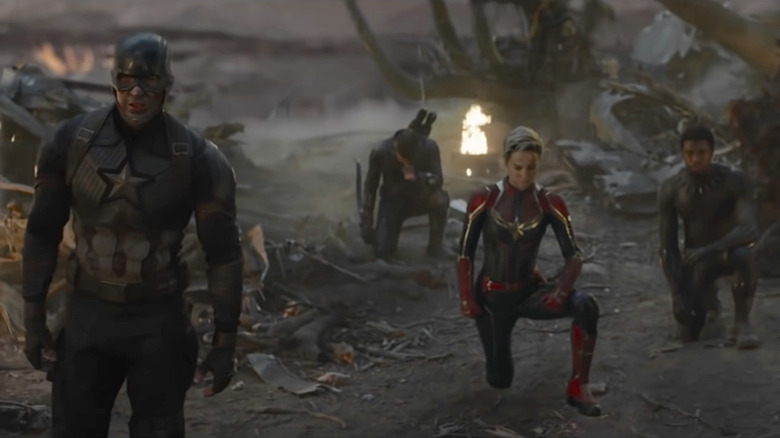The Most Expensive Deleted Scenes Filmed
Filmmaking is a tricky business. It's a long journey from the script to the screen, and a lot of great and not-so-great scenes get left on the cutting room floor, costing the studio time and money. Here's a look at some of our favorite films whose deleted scenes came at a high price — creatively and financially.
World War Z's darker final act
If you watched "World War Z" and thought the ending seemed out of place, there's a good reason why. After the battle in Jerusalem, the movie ended on a jarring small-scale switch, with Gerry wandering around a research laboratory—but the ending we got was the backup option for the original script, which finished things off in far more epic fashion.
In the original ending, Gerry and his sidekick Segen made it to Russia and joined the anti-zombie army. The story then skipped ahead to the winter, showing Gerry leading the Russian army into massive zombie battles. He contacted his wife Karin, who revealed she'd turned to prostitution for survival—and that she'd left him and was in a relationship with one of the soldiers we saw at the beginning of the film. Not about to lose his family, Gerry embarked on a quest across Siberia, trying to reach the Pacific Ocean and find a way to his wife's camp in America.
It's a downer ending that would've set up a whole trilogy of "World War Z" films, but this wasn't just a script idea — most of the third act was actually filmed, but at the last minute, Paramount decided to go with a lighter, more hopeful ending. The reshoots ended up costing $25 million. That's a huge amount of money, especially since none of the original third act was used in the final cut. Frankly, the original version sounds awesome. We never knew we needed a bearded Brad Pitt leading the Russians into epic zombie battles, but now they've got to make a sequel featuring that storyline.
The octopus scene from The Goonies
In the original version of this 1985 cult classic, the Goonies careen down waterslides and land in a lagoon only to be attacked by a rubbery giant octopus. Just when you thought that wasn't ridiculous enough, Data (Ke Huy Quan) stuffs his Walkman cassette player into its mouth while blasting a pop track written for the film entitled "Eight Arms to Hold You," and the octopus swims away. Most likely the fabled scene was cut for time — and/or deemed unnecessary and cheesy-looking. When the Disney Channel acquired the TV rights to the film in the 90s, the network added the scene back in to make up for lost airtime after deleting scenes deemed "inappropriate for young children." While the scene is only included in the DVD extras, one remnant still remains in the final cut of the film.
When reporters are interviewing the Goonies at the end, Data tells them, "The octopus was very scary!" Though it comes off to both the reporters and the audience as one of the teen's tall tales, it turns out the gang really did have a close encounter of the eight-armed kind. For his part, director Richard Donner was good-natured about the whole thing, joking to Empire in 2009, "I guess the company that was using the water tank before us had stupidly left an octopus in there."
Stairway to Heaven in Almost Famous
There's a lot of great rock n' roll featured in Cameron Crowe's cinematic ode to his own past as an adolescent journalist for Rolling Stone in the early '70s, but one major band didn't make the final cut. When offered a chance to write a story about Stillwater, a group on the brink of stardom, 15-year-old William Miller (Patrick Fugit) must convince his mother (Frances McDormand) to let him travel with the band for weeks. In the original theatrical version, William winds up getting her on board by promising to call her from every town and vowing he won't miss a single test.
However, Crowe originally shot a sequence in which William, two nameless women, and his sister's ex-boyfriend play Led Zeppelin's masterpiece "Stairway to Heaven" for her in an effort to show just how much music means to William. The ex-boyfriend hilariously lip-syncs and air-drums, but the 11-minute sequence kills the momentum of the film — and feels self-indulgent and awkward. Crowe ultimately cut it because he couldn't afford the licensing rights to the track.
Rogue's scenes in X-Men: Days of Future Past
With its crazy time-travel plot, "X-Men: Days of Future Past" is packed with familiar faces, but unfortunately, that means limited screen time for some of our favorite characters, including Anna Paquin's Rogue. The "True Blood" actress spent a week filming several elaborate scenes for the 2014 blockbuster alongside original trilogy vets Ian McKellen, Patrick Stewart, and Shawn Ashmore, but none of it wound up in the finished film. Director Bryan Singer told Entertainment Weekly, "Through the editing process, the sequence became extraneous...like many things in the editing process, it was an embarrassment of riches and it was just one of the things that had to go."
Paquin didn't sound too disappointed in an interview with Yahoo!, saying, "I got to hang out with my friends for five days in Montreal, see people I've known for two decades, and go play. Did it end up in the movie? No. Well, it was fun anyway." But after fan outcry, Singer and 20th Century Fox released a "Rogue Cut" of the film on DVD, restoring 17 minutes of previously cut footage that included Paquin's sequences.
The original tragic ending of Little Shop of Horrors
If all had gone as director Frank Oz and screenwriter Howard Ashman had initially planned, this 1986 adaptation of the Broadway musical wouldn't have ended quite as happily. The pair intended to use the ending from the stage version of "Little Shop of Horrors," with the Audrey II eating Audrey (Ellen Greene) and Seymour (Rick Moranis) and terrorizing the world, but test audiences hated it. Oz recalled to Entertainment Weekly, "For every musical number there was applause, they loved it, it was just fantastic...until we killed our two leads. And then the theater became a refrigerator, an ice box. It was awful and the cards were just awful. They were saying that they hated us killing them. You have to have a 55 percent 'recommend' to really be released, and we got a 13."
The elaborate 23-minute sequence, which cost a reported $5 million, was scrapped and a new ending was shot with the two leads alive and well. Though a black-and-white version of the original ending was included on a 1998 DVD release, full-color footage was finally included in a Director's Cut edition Blu-ray in 2012.
The Jitterbug dance number from The Wizard of Oz
The Wicked Witch (Margaret Hamilton) uses a lot of different tactics to try to stop Dorothy (Judy Garland) and her friends in "The Wizard of Oz," but one never made it into the final version of the film. In the lost "Jitterbug" sequence, Dorothy, the Scarecrow (Ray Bolger), Tin Man (Jack Haley), and Cowardly Lion (Bert Lahr) travel through the Haunted Woods only to be attacked by evil bugs that cause them to break out in song and dance, i.e. get the "jitters."
Also a popular dance style at the time, the "Jitterbug" was actually a remnant of an older version of the script that was tossed out. The whole number cost about $80,000 and took five weeks to shoot, but it was excised when producers deemed the film too long. Though the actual footage was destroyed, composer Harold Arlen captured a dress rehearsal of the number on home video, later included as an extra on the DVD version of the film.
Chris Hemsworth's disco dance from Ghostbusters (2016)
Dreamy, dimwitted secretary Kevin (Chris Hemsworth) isn't much help around the Ghostbusters office. He's more concerned with picking out his best audition headshot and flirting with the ladies than answering the phone. But when he's possessed by bad guy Rowan during the film's climax, he uses his spellbinding looks to literally make hordes of Army personnel and police officers do whatever he wants, including a "Saturday Night Fever"-esque disco pose. If you think it feels like the perfect segue into a dance number, you'd be right. Director Paul Feig spent two days and somewhere in the vicinity of seven figures shooting an entire dance number with Hemsworth and extras to the Bee Gees' "You Should Be Dancing." The scene turns Times Square into a "giant discotheque," Feig told Vulture, but it was ultimately cut.
"It was stopping the flow for the audience," Feig recalled, "because even though they really loved it, they were having trouble coming back out of it. It was making the rhythm a little too goofy, in a weird way, and it was hurting our story a little bit ... but it was Chris Hemsworth doing this amazing dance sequence!" Rather than completely scrap the footage, Feig re-edited it and used it during the film's credits, so audiences would still get to see Hemsworth busting a move.
Superman returns to Krypton in Superman Returns
Before DC decided to reboot the Superman franchise yet again in 2013 with Zack Snyder at the helm, Bryan Singer's 2006 entry starring Brandon Routh as the caped superhero flew into movie theaters with fairly mixed reviews. "Superman Returns" also nearly arrived with a completely different opening sequence.
While the basic plot of the film deals with Superman's return to Earth after a five-year absence, Singer shot a wordless, visually stunning five-minute opening sequence with Routh's Kal-El returning to Krypton. The scene, which cost an estimated $10 million, feels like something closer to Stanley Kubrick's "2001: A Space Odyssey" than a slick superhero film. It's slow and contemplative rather than bombastic, and perhaps this is why producers ultimately had Singer cut it. The scene was finally released as an extra on the 2011 "Superman Anthology" Blu-ray set, further dividing critics and fans on the one-off superhero flick.
The pie fight from Dr. Strangelove
At the end of "Dr. Strangelove or How I Learned to Stop Worrying and Love the Bomb," the U.S. dispatches a group of B-52s to drop H-bombs on the Soviet Union but winds up abandoning the plan at the last minute. Unfortunately, one plane manages to drop its bombs, which triggers a nuclear chain reaction to the elegant strains of "We'll Meet Again." However, director Stanley Kubrick envisioned a much different and messier ending to his 1964 satirical masterpiece. In an effort to show the complete absurdity of war, Kubrick filmed a giant pie fight between his principal cast in the War Room in just one take due to the mess and the expense of shooting. Editor Anthony Harvey recalled, "It devolved into a kind of silent Mack Sennett sort of thing, with everybody getting hit by custard pies."
After a test screening on the day of John F. Kennedy's assassination, Kubrick agreed, "it was too farcical and not consistent with the satiric tone of the rest of the film" and cut the scene for both creative and political reasons. Though it's unknown if the actual footage still exists, still photos of the scene are included in the DVD extras.
Movie theater shooting scene from Gangster Squad
The 1940s mob movie starring Sean Penn, Ryan Gosling, Josh Brolin, and Emma Stone once featured a key scene set at Grauman's in Los Angeles during which a pack of gangsters open fire on the audience, causing the theater to erupt in mayhem. The film was set to be released in early September of 2012, but tragedy struck. That July in Aurora, CO, a deranged gunman opened fire on a theater full of moviegoers at a midnight screening of "The Dark Knight Rises," killing 12 people and injuring 70 more. Warner Bros., the studio behind both "The Dark Knight Rises" and "Gangster Squad," immediately pulled the latter's trailer from theaters and pushed back its release date in order to allow for extensive rewrites and reshoots.
Released in early 2013, "Gangster Squad" featured an all-new ending, and director Ruben Fleischer had no problem with it, telling IndieWire during a press conference, "We felt it necessary to reshoot that sequence, and I'm proud of the fact that we did. I think that we didn't compromise the film or our intent, and I think the [newly shot] Chinatown sequence is really well done, and that we should all respect the tragedy and not draw associations to our film."
Eric Stoltz's scenes from Back to the Future
As most "Back to the Future" fans know, Eric Stoltz was originally cast as Marty McFly, the puffy vest-wearing teenager sent back to 1955 in a souped-up DeLorean. Director Robert Zemeckis initially wanted to hire Michael J. Fox, but his "Family Ties" shooting schedule was too demanding at the time and hired Stoltz instead. Five weeks into filming, Zemeckis and Steven Spielberg knew they needed to replace Stoltz.
In an excerpt from a book on the making of the film called "We Don't Need Roads: The Making of the Back to the Future Trilogy" (via Vulture), co-star Lea Thompson remarked, "Eric had such an intensity. He saw drama in things. He wasn't really a comedian, and they needed a comedian. He's super-funny in real life, but he didn't approach his work like that, and they really needed somebody who had those chops." Zemeckis and Spielberg quickly negotiated with Universal to replace Stoltz with Fox, adding a reported $3 million to the film's budget and extra time onto its shooting schedule. Soon Fox was on set at the Twin Pines Mall shooting with Christopher Lloyd, and the rest is history.
Aside from a few clips included in "Making of" featurettes on DVD and an assortment of set photos, Stoltz's take on Marty McFly remains largely under wraps to the public, though fans have shown interest in its release over the years. If we've learned anything from Marty and Doc Brown, it's that sometimes going back in time isn't all it's cracked up to be.
The Brothers Grimm fight in a tree
A curious group of movies were released in and around the 2000s that defy simple classification, but all seem surprisingly similar. For lack of a succinct nickname, we'll call them modern fantasy-horror-adventures in blended medieval-Victorian-steampunk settings. That sounds convoluted, but it's explained best by its constituent movies, such as "The Mummy," "Red Riding Hood," "Van Helsing," and "Hansel & Gretel: Witch Hunters." All of them devoted considerable time and money to combining digital and practical effects, which made them all extra expensive. One film in this odd subgenre, "The Brothers Grimm," wasted a lot of that expense on a single battle which was cut from the movie entirely.
The scene, which survives as a DVD extra and on YouTube, shows brothers Will Grimm (Matt Damon) and Jake Grimm (Heath Ledger) trying to save Angelika (Lena Headey) from a massive tree that's magically come to life. It's apparent that many of the roots and branches were built as models, while the writhing, tentacular branches were all digital, and the combination all but guarantees the scene a hefty price tag. Director Terry Gilliam confirmed as much to The Guardian, revealing that "I cut out the most expensive scene in the movie... It'll be on the DVD – the most expensive extra ever made. It's a great sequence, a fight in a tree."
Shailene Woodley's scenes in The Amazing Spider-Man 2
If you've seen "The Amazing Spider-Man" and its sequel, you know they revolve around Peter Parker and Gwen Stacy, played by Andrew Garfield and Emma Stone. The two films are notable for their decision to focus on the relationship between Parker and Stacy, replacing the Parker and Mary Jane relationship made famous in Sam Raimi's "Spider-Man" trilogy. What you may not know is that M.J. was originally in "The Amazing Spider-Man 2," appeared in multiple scenes, and was even played by well-known actress Shailene Woodley. Unfortunately for both Woodley and Mary Jane fans, her entire presence was cut from the film before release.
Producer Matt Tolmach explained the decision to cut Woodley to the Los Angeles Times, saying, "It felt like a distraction. You can't have Peter thinking about Gwen every moment and then there's this girl next door who's suddenly there. We weren't ready for it." Woodley's pay for other projects in the 2010s tended to hover around the $200 to $250 thousand mark per movie (or even per episode, like in "Big Little Lies"), making it likely her deleted scenes cost hundreds of thousands — especially when factoring in Garfield's time, given his $1 million payday for the movie.
Watchmen cut Tales of the Black Freighter
If you've seen 2009's "Watchmen," you might understandably question how anything could have been cut from it all — after all, the theatrical release was already a "The Lord of the Rings"-worthy 163 minutes long. Yet the movie does have a director's cut, bumping the runtime to 186 minutes, and that's not even including the deleted scene we're talking about here. "The Watchmen" also has an "Ultimate Cut," a 215-minute epic that includes its own 26-minute animated movie-within-a-movie — which makes for one whopper of a deleted sequence.
The animated movie is known as "Tales of the Black Freighter" and is based on a story of the same name that appeared serially in Alan Moore's original "Watchmen" comic. The big-screen (or rather, could have been big-screen) version went all out, casting Gerard Butler as the lead character and Jared Harris as his companion.
The big-name actors, combined with the cost of animation, made the sequence a costly one. Diane Nelson, president of Warner Premiere, revealed to The New York Times that the project "was 30 percent to 50 percent higher than a typical direct-to-DVD effort," which extended over its exceptional length, makes "Tales of the Black Freighter" some massively expensive deleted content.
The Raid 2's gang fight
If you haven't seen "The Raid" or its sequel, "The Raid 2," you're not alone — despite both pictures receiving excellent reviews from critics and fans alike, neither became a commercial hit. As productions of the Indonesian film industry, the two movies had a hard time reaching global audiences as effectively as their American or Japanese counterparts, so both remain hidden cinematic gems. Nonetheless, the movies retain their small but dedicated following, thanks in large part to their consistently over-the-top action and violence — both of which are on display (and then some) in a large-scale deleted scene known as "Gang War."
The scene is available on Vimeo, though a warning for those who haven't seen the films — it's exceptionally violent. "Gang War" was personally posted by the film's director, Gareth Evans, as part of the marketing for "The Raid 2," and under the post, Evans gives his own colorful approximation of the sequence's cost. "This was probably the hardest for me to cut, " writes Evans. "due to the fact that the production on this scene lasted around 6 days of shooting, [and] it cost us a f*** load to make."
As hard as it is to pin an exact amount to "Gang War," Evans' description gives us a pretty good idea that it certainly wasn't cheap.
Die Hard 2's Black & Decker product placement
If there's one lesson to be learned from reading about expensive deleted scenes, it's that movies cost an arm and a leg (and a few million more arms and legs) to make. That's why production companies sometimes go looking for funds in the weirdest of places, which is where product placement comes in. Sometimes, producers are desperate enough for that sweet, sweet product placement money that their film ends up becoming essentially one giant ad. Happily, "Die Hard 2" avoided that fate. Tragically, it only did so because it ended up deleting its product placement, prompting a very costly lawsuit.
In exchange for $20,000 from Black & Decker, "Die Hard 2," producers agreed to feature a scene in which hero John McClane used one of the company's signature Univolt power drills. Understandably expecting the scene to make it to theaters, Black & Decker began marketing the drill with "Die Hard" tie-in ads — not a cheap affair. When the aforementioned scene never made the movie (seemingly a major oversight), Black & Decker sued distributor 20th Century Fox for $150,000, hoping to recoup its advertising costs.
The thing is, Black & Decker's case was strong enough that 20th Century Fox agreed to settle out of court, likely causing them to rue the day they ever dared cut a convenient, durable product like the Univolt.
All of the Batgirl movie
It may not be first in your mind when it comes to deleted scenes (mainly because it had no non-deleted scenes) but Warner Bros' "Batgirl" more than deserves a spot in the conversation when it comes to wasted money. Thanks to being canceled after its production had all but wrapped, the entire "Batgirl" movie has become one giant deleted scene and therefore carries one giant price tag.
Between its initial $80 million budget and added costs due to pandemic precautions, "Batgirl" cost nearly $90 million to make, meaning it is one of the most expensive pieces of deleted media ever. The film's cost included extensive practical effects, CGI, stylistic sets, props, and actor salaries — especially for A-list cast members like J.K. Simmons and Brendan Fraser. In addition to production costs — as if $90 million needs any addition — the cancellation of "Batgirl" also carried another colossal cost: after 30 years, fans were finally going to realize their dream of seeing fan favorite Michael Keaton wear the cowl again.
If it's any consolation for fans, Keaton did walk away from his scenes in "Batgirl" with a cool $2 million — though that almost certainly isn't a consolation for the execs that canceled the film to save money.
Everything cut from The Force Awakens
Of course, the easiest ways to determine the most expensive deleted scenes are from financial disclosures and director's admission, but there is another way: dividing a movie's budget by its runtime gives you an average cost per minute of movie. Given that "Star Wars: The Force Awakens" was made with the largest budget of all time at over $533 million, it also has the highest cost per minute — meaning every deleted minute was the most expensive, too.
It's not the insane budget that makes "The Force Awakens" deleted scenes expensive — it also has a ton of them. You might not know about its deleted scenes, as the "Star Wars" franchise doesn't tend to publicize its cut content in the way that other franchises (like, for example, Marvel) do, but they are plentiful. The "Star Wars" YouTube account has just a brief teaser of what was cut, but even that short sequence makes it clear how much the scenes must have cost.
Big-budget actors like Harrison Ford and Adam Driver have minutes of their work cut, entire practical effects sets complete with costumes and props are cut, and even scenes with finished digital effects are cut, like those featuring CG alien Maz Kanata.
The original ending of Avengers: Endgame
There are few movies as titanic in the industry as "Avengers: Endgame," and we're not even talking about the Mad Titan Thanos. Upon release, it snapped several box office records to dust (so okay, we're talking about him): highest-grossing opening weekend, fastest film to reach $1 billion, numerous single-day records, and even (for a while) highest-grossing film of all time. Still, as the old saying goes, it takes money to make money, and "Avengers: Endgame" is no exception, costing an estimated $400 million. A huge portion of that was its unprecedentedly star-studded cast, and unfortunately for fans, many of that cast's group scenes ended up on the cutting room floor.
As the film's screenwriters told The New York Times, the climactic battle sequence was originally "an even much longer battle, with its own three-act structure," which included "a scene in a trench where, for reasons, the battle got paused for about three minutes and now there are 18 people all going... 'I'm going to do this.'" As you can imagine, a mere second of filming involving 18 Avengers actors would cost thousands.
While it is unclear if that scene ever made it to production, well over ten minutes of filmed footage was cut, much of which featured the franchise's signature cast members. With the knowledge that Robert Downy Jr. earned $20 million upfront for his role, Chris Evans and Chris Hemsworth made $15 million each, and dozens of other big stars made millions, we can safely conclude that the "Avengers: Endgame" deleted scenes cost millions.
